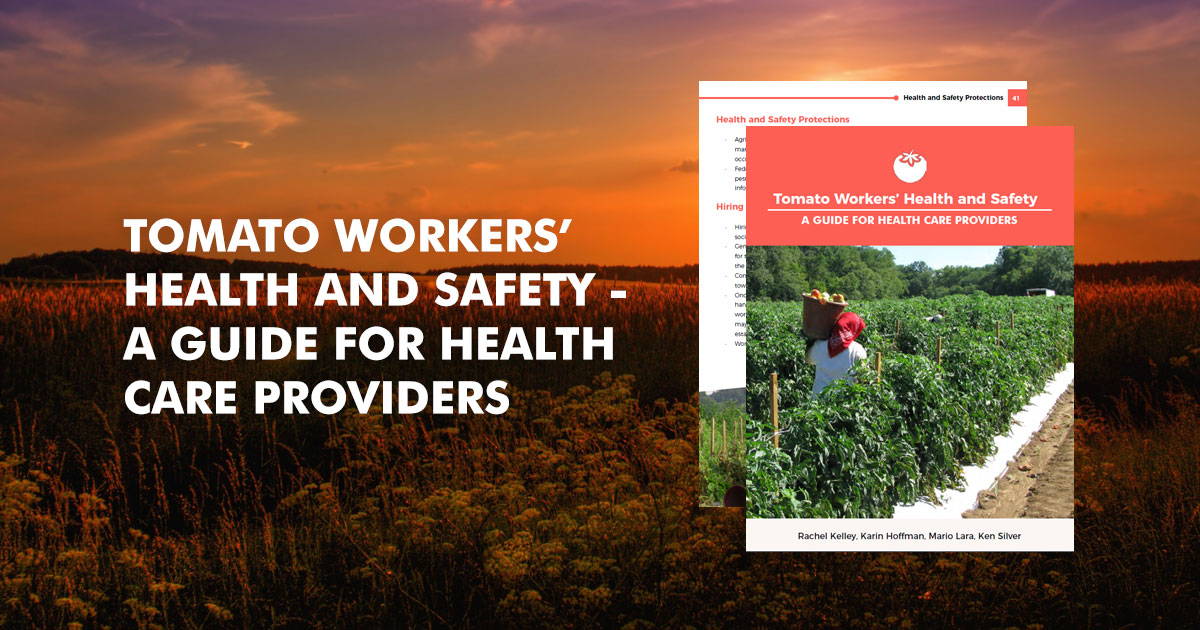¡Cuídate! is an educational resource on the prevention of musculoskeletal injuries at work. This comic is in Spanish, English and Haitian Creole.
- injury prevention ENGLISH 2019.pdf (19.34 MB)
- injury prevention SPANISH 2019.pdf (11.9 MB)
- injury prevention WEB CREOLE AUG 14 2019.pdf (12.77 MB)
This pesticide comic book targets migrant and seasonal farmworker families to educate parents about children's risks to pesticide exposure and ways to minimize these risks. The latest edition is currently only available Spanish though we are working on releasing an updated version of the comic in English.
We are currently "sold out" of our printed pesticide comic book. We are looking for additional funding. In the meantime, please download an e-copy.
- PesticidesNearbyButHealthyENG_2007_0.pdf (1.33 MB)
- AUNQUE-CERCA-SANO-2020_PRINT.pdf (21.69 MB)
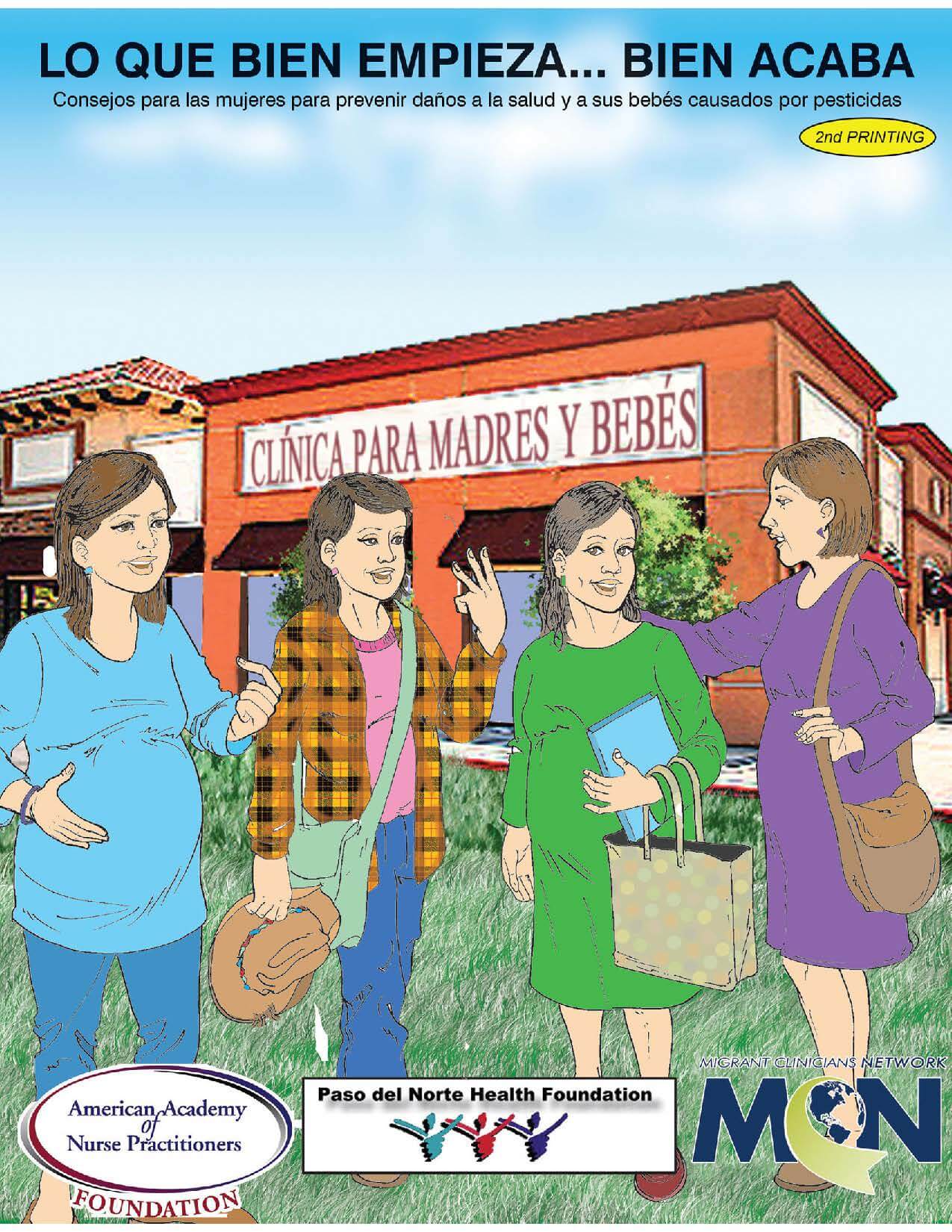
MCN Spanish educational comic book that addresses pesticide exposure in women of reproductive age. LO QUE BIEN EMPIEZA...BIEN ACABA: Consejos para las mujeres para prevenir daños a la salud y a sus bebés causados por pesticidas.
- lo que bien empiezacomic 2015-20mb.pdf (16.45 MB)
This Community Health Worker manual (English/Spanish) offers information about health risks from pesticide exposure and ways to lessen these risks. It includes useful information and tips to successfully work in the community.
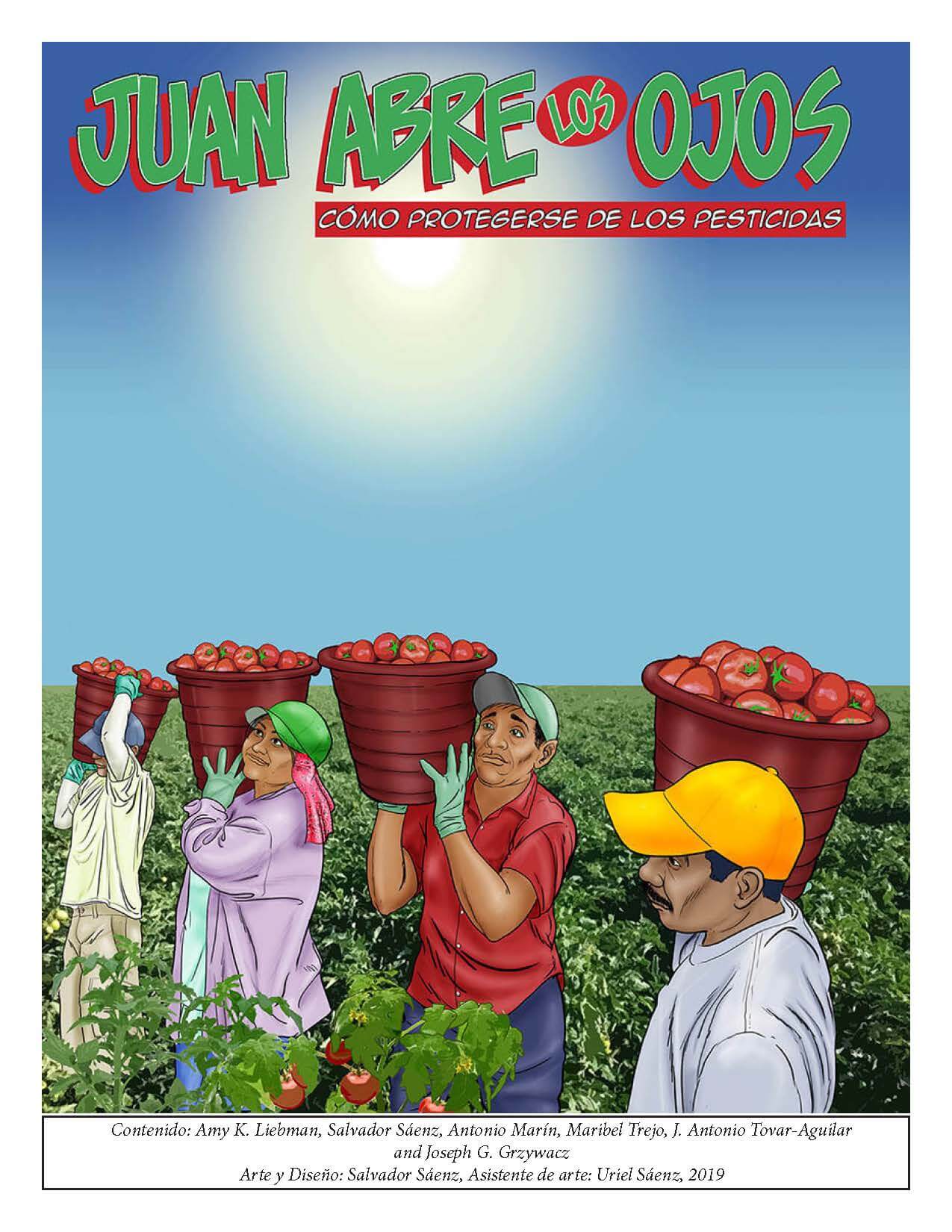
This comic book tells us how Juan learned to protect himself from pesticides at work. This resource presents in a very simple and entertaining way what are the sources of exposure to pesticides, their short- and long-term effects on the body, and what can be done to protect oneself from them. It is a great resource for farmworkers and promotores de salud!
Worker Protection Standard Pesticide Safety Training Curriculum - Culturally and linguistically appropriate curriculum with supporting resources for training workers on the revised Worker Protection Standard. Developed by the Florida State University PISCA Project and Migrant Clinicians Network.
- WPS PesticidasEnglishFINAL4_2021Website.pptx (33.52 MB)
- WPS PesticidasSpanishFINAL4_2021_Website.pptx (19.67 MB)
- WPSPesticidesFlipChartFINAL_1_23_2020.pdf (8.32 MB)
- WPS Pesticide Facilitator Guide English 2020.pdf (2.03 MB)
- WPS Pesticide Training Facilitator Guide Spanish 2020.pdf (1.99 MB)
- Juan Abre los Ojos como protegerse de los pesticidas (01 14 2020)_0.pdf (7.25 MB)

This comic book tells us how Juan learned to protect himself from pesticides at work. This resource presents in a very simple and entertaining way what are the sources of exposure to pesticides, their short- and long-term effects on the body, and what can be done to protect oneself from them. It is a great resource for farmworkers and promotores de salud!

FECHA: 11 de Octubre de 2017 @ 1 PM (ET)
PRESENTADORES:
- Alma R. Galván, MHC, Migrant Clinicians Network
- Richard Rabin, MassCOSH
- Rossana Coto-Batres, MSW, Northeast New York Coalition for Occupational Safety and Health (NENYCOSH)
Crédito de educación continua
Para recibir credito de Trabajador/a de Salud Comunitaria o Educacion de Continua de Enfermera después de ver alguno de estos seminarios usted debe hacer lo siguiente:
- Completar la evaluación participante asociado a cada webinar
- Enviar un correo electrónico con su nombre y apellido indicando que ha completado a malvarado@migrantclinician.org
Descripción
Conforme las familias regresan a sus hogares en Houston, una vez que las inundaciones causadas por los Huracanes Irma y María se van retirando, esto se convierte en una carrera contra el tiempo. Un olor sofocante llena los cuartos de las casas, los charcos permanecen en los pasillos, y el moho se multiplica rápidamente. En cuestión de días, los patios ensopados de los vecinos se convierten en tiraderos de basura, conforme los trabajadores empiezan a quitar de las casas las paredes con moho, los pisos y los cielos destruidos, así como los muebles dañados. En este proceso, los trabajadores y muchos residentes se exponen al agua contaminada con químicos y basura, materiales de construcción peligros y alimañas dañinas. Pero hay otros riesgos adicionales, estructuras inestables y posibles intoxicaciones por monóxido de carbono de los generadores que trabajan incansablemente en espacios con poca ventilación. La exposición a asbestos, sílice y plomo son también peligros comunes para estos trabajadores.
Katrina, Sandy, Harvey, Irma y ahora Maria: son nombres de tormentas que nos indican las diferentes comunidades que terminaron bajo el agua, pero muchas de las historias emanadas de ellas, sobre la limpieza -- y los peligros involucrados-- son las mismas. Con resiliencia y determinación, las comunidades se tratan de reconstruir, pero la reconstrucción necesita una fuerza de trabajo inmediata, lista para este trabajo peligroso y extenuante.
Las operaciones de recuperación después del desastre, limpieza y reconstrucción presentan muchos riesgos y peligros para los trabajadores. Muchos de ellos realizan este trabajo sin el equipo de seguridad o el entrenamiento de mitigación de peligros adecuado.
En la recuperación de una supertormenta, ¿cuáles son las vulnerabilidades que los trabajadores enfrentan y qué significa eso para la seguridad y la salud del trabajador? Las siguientes preguntas surgen para los proveedores y trabajadores de salud comunitarios que cuidan y se preocupan por estos trabajadores: ¿cuáles son los puntos claves que necesitamos entender para poder cuidar de aquellos involucrados en estos esfuerzos de limpieza y reconstrucción? y ¿qué podemos hacer para que ellos mismos prevengan las lesiones y las enfermedades?
Este seminario en línea recupera experiencias obtenidas de desastres naturales anteriores y ofrece recursos que le pueden guiar en su trabajo. Ofreceremos casos reales para ilustrar los peligros y revisaremos formas en que los trabajadores se pueden proteger a sí mismos, incluyendo el entendimiento de sus derechos y responsabilidades.
Objetivos de aprendizaje
- Los participantes identificarán los peligros más comunes y críticos que los trabajadores y residentes encuentras cuando se involucran en la demolicion y reconstruccion despues de un desastre.
- Los participantes articularán las mejores estrategias para educar a los trabajadores y residentes sobre como prevenir lesiones y enfermedades durante las actividades de limpieza y reconstrucción después de huracanes y supertormentas.
- Los participantes enlistarán al menos tres recursos que pueden usar para guiar a los trabajadores y residentes durante la demolición y reconstrucción después de un desastre.
Este proyecto cuenta con el apoyo de la Administración de Recursos y Servicios de Salud (HRSA) del Departamento de Salud y Servicios Humanos de los Estados Unidos bajo el acuerdo de cooperación número U30CS09742, Asistencia Técnica a Centros de Salud Comunitarios y Migrantes y Personas sin Hogar por $ 1,094,709.00 con 0% del total Proyecto NCA financiado con fuentes no federales. Esta información o contenido y las conclusiones son las del autor y no deben ser interpretadas como la posición o política oficial de, ni cualquier endosos deben ser inferidos por HRSA, HHS o el Gobierno de los Estados Unidos.
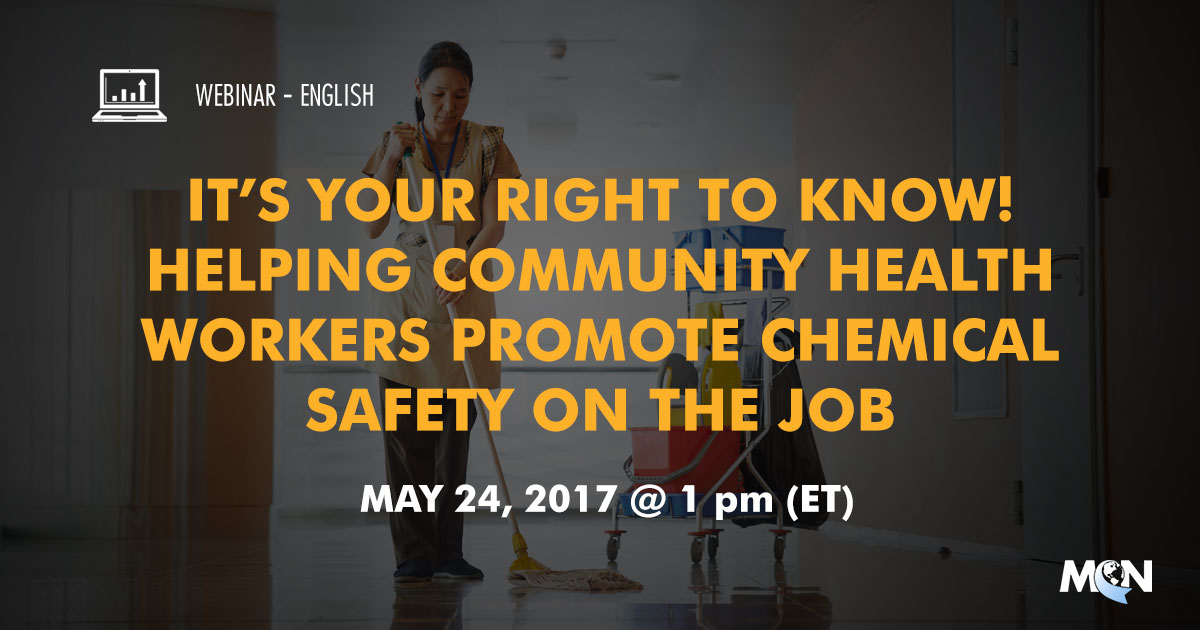
DATE: May 24, 2017, 1 pm (ET)
SPEAKERS: Juliana Simmons, MSPH, CHES
Continuing Education Credit
To receive CME* or CNE credit after viewing this webinar, you must:
- Complete the Participant Evaluation associated with this webinar
- Send an email with your first and last name stating which webinar you completed to contedu@migrantclinician.org
Description
José Navarro was excited for his new career after landing a job in the poultry industry. After five years on the job, 37 year-old Navarro began coughing up blood. He died soon after when his lungs and kidneys failed. His death triggered a federal investigation raising questions about the health risks associated with the use of toxic chemicals in poultry plants.
Millions of workers are exposed to chemicals everyday on the job. All workers have the right to know about the chemicals they work with and community health workers can be an important source of information and support for workers. This workshop will teach community health workers how to explain what happens when someone is exposed to chemicals and how workers can best protect themselves
Learning Objectives
- Recognize how workers become exposed to chemicals and illnesses
- Describe basic safety practices when working around chemicals
- Understand the role of community health workers in identifying and preventing work related illnesses and hazards
This project is supported by the Health Resources and Services Administration (HRSA) of the U.S. Department of Health and Human Services (HHS) under cooperative agreement number U30CS09742, Technical Assistance to Community and Migrant Health Centers and Homeless for $1,094,709.00 with 0% of the total NCA project financed with non-federal sources. This information or content and conclusions are those of the author and should not be construed as the official position or policy of, nor should any endorsements be inferred by HRSA, HHS or the U.S. Government.
Available in English and Spanish!
Created by MCN, medical student Rachel Kelley of UCSF, and collaborators at East Tennessee State University, this guide is intended to be a reference for health care providers who work with people employed in the U.S. tomato industry. It aims to prepare providers with a more detailed understanding of hazards, health issues, and work processes associated with different tomato industry jobs.
This guide draws on published research, experienced health professionals’ advice, and information gathered from interviews and focus groups conducted with 36 tomato workers from diverse backgrounds and 14 community leaders familiar with tomato workers’ health in multiple states. It is important to note that health and safety conditions at any particular farm or company may vary from what is described here. Furthermore, individual workers may experience the same set of conditions differently.
The first section of the guide focuses on health hazards and health conditions commonly encountered in tomato production. The second section consists of detailed descriptions and illustrations of different tomato production tasks. The third section covers “human resources” information and policies that apply to U.S. agricultural workers generally. The appendices contain a Spanish-English glossary, further detail about different types of pesticides, information about agricultural occupational health policies and regulation, and a list of resources and readings.
Chapter 14: Pesticides Are Poison from the Hesperian.org health guide: A Community Guide to Environmental Health.
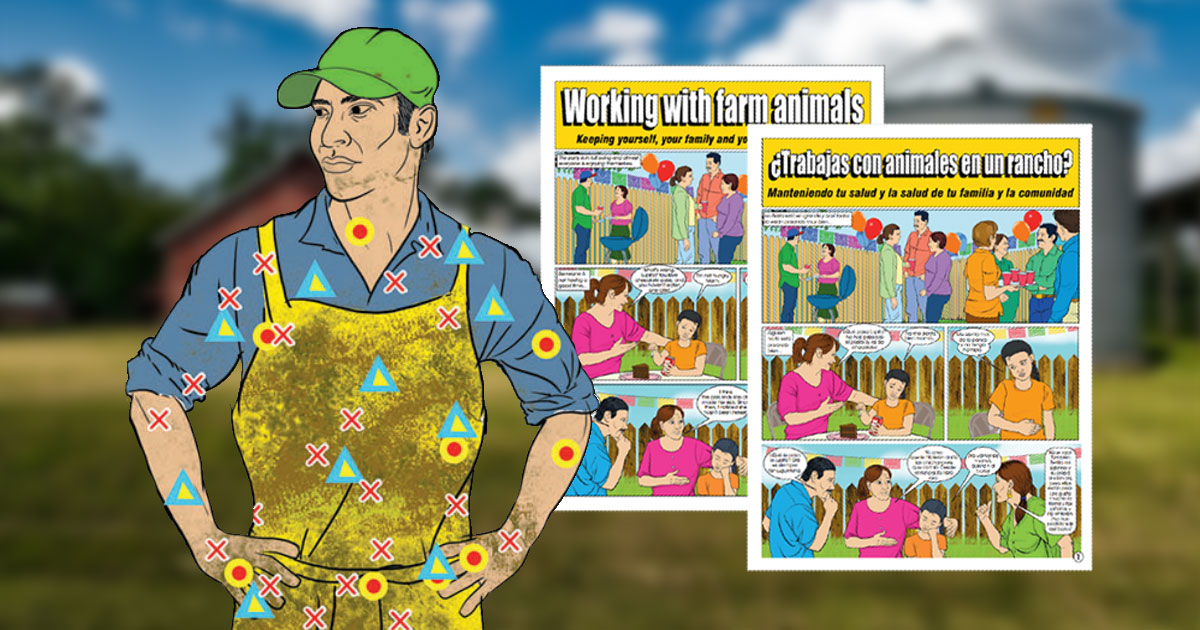
Libro cómic educativo bilingüe sobre cómo prevenir las enfermedades zoonóticas. Desarrollado por MCN en colaboración con la Universidad Estatal de Ohio.
- Working with farm animals_1.pdf (13.33 MB)
- Trabajos con animales en un rancho_1.pdf (13.31 MB)
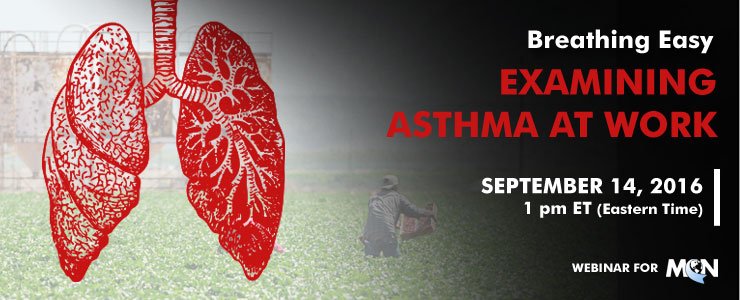
DATE RECORDED: September 14, 2016 at 1 pm ET
PRESENTED BY: Robert Harrison, M.D., M.P.H.
This material will be produced under grant number SH-27640-15-60-F-48-SH5 from the Occupational Safety and Health Administration, U.S. Department of Labor. It will not necessarily reflect the views or policies of the U.S. Department of Labor, nor does mention of trade names, commercial products, or organizations imply endorsement by the U.S. Government.
- https://youtu.be/MpNJ-qxL1O0
- http://www.migrantclinician.org/
- https://www.osha.gov/Publications/OSHA3707.pdf
- https://www.thoracic.org/statements/resources/eold/an-official-ats-statement-work-exacerbated-asthma.pdf
- http://journal.publications.chestnet.org/article.aspx?articleid=1044851
- http://www.nj.gov/health/eoh/survweb/wra/documents/asthmagens.pdf
- http://www.ccohs.ca/oshanswers/diseases/asthma.html
- http://www.aoec.org

DATE RECORDED: September 14, 2016 at 1 pm ET
PRESENTED BY: Robert Harrison, M.D., M.P.H.
- Recorded Webinar
- Participant Evaluation
- Presentation Slides (PDF)
This material will be produced under grant number SH-27640-15-60-F-48-SH5 from the Occupational Safety and Health Administration, U.S. Department of Labor. It will not necessarily reflect the views or policies of the U.S. Department of Labor, nor does mention of trade names, commercial products, or organizations imply endorsement by the U.S. Government.

DATE RECORDED: August 17, 2016 at 1 pm ET
PRESENTED BY: Amy Liebman, MPA, MA and Wilson Augustave, member of MCN’s Board of Directors and Senior HIV Case Manager at Finger Lakes Community Health
This material will be produced under grant number SH-27640-15-60-F-48-SH5 from the Occupational Safety and Health Administration, U.S. Department of Labor. It will not necessarily reflect the views or policies of the U.S. Department of Labor, nor does mention of trade names, commercial products, or organizations imply endorsement by the U.S. Government.
- http://migrantclinician.adobeconnect.com/p50hmpih2ti/?OWASP_CSRFTOKEN=3e2b187aeeb1282a41d5df37d8a98c307a7e00006662aca9d5f21dc12aa036c4
- http://www.migrantclinician.org/
- http://workerscomphub.org/
- http://workerscomphub.org/navigating-system
- https://www.osha.gov/workers/index.html
- http://www.coshnetwork.org/know-your-rights
- http://hesperian.org/books-and-resources/
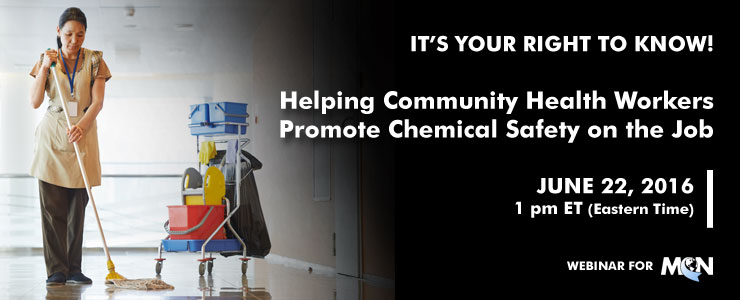
DATE RECORDED: June 22, 2016
PRESENTED BY: Kerry Brennan
This material will be produced under grant number SH-27640-15-60-F-48-SH5 from the Occupational Safety and Health Administration, U.S. Department of Labor. It will not necessarily reflect the views or policies of the U.S. Department of Labor, nor does mention of trade names, commercial products, or organizations imply endorsement by the U.S. Government.
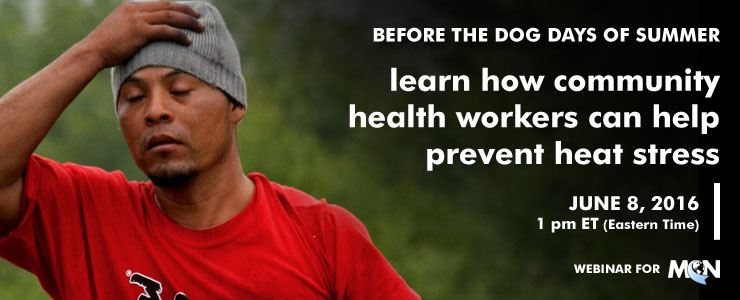
DATE RECORDED: June 8, 2016
PRESENTED BY: Juliana Simmons, MSPH, CHES
This material will be produced under grant number SH-27640-15-60-F-48-SH5 from the Occupational Safety and Health Administration, U.S. Department of Labor. It will not necessarily reflect the views or policies of the U.S. Department of Labor, nor does mention of trade names, commercial products, or organizations imply endorsement by the U.S. Government.
- https://youtu.be/qcCci3GQs04
- http://www.migrantclinician.org/
- https://www.osha.gov/SLTC/heatstress/prevention.html
- http://www.farmworkerjustice.org/sites/default/files/FJpesticidetrainingspanish2016.pdf
- https://www.osha.gov/SLTC/heatstress/index.html
- https://www.osha.gov/SLTC/heatillness/index.html
- https://www.osha.gov/SLTC/heatstress/industry_resources.html
- http://www.dir.ca.gov/dosh/heatIllnessQA.html
- http://www.lni.wa.gov/Safety/Topics/AtoZ/HeatStress/
- http://en.hesperian.org/hhg/Workers%27_Guide_to_Health_and_Safety:Dangers_from_heat
- http://www.naplesnews.com/news/crime/report-farmworkers-death-should-have-been-prevented-2738c212-4e00-109c-e053-0100007fd972-363310521.html
- http://www.cdc.gov/niosh/topics/heatstress/heatrelillness.html
http://www.asbestosdiseaseawareness.org/
ADAO is the largest independent nonprofit in the U.S. dedicated to preventing asbestos exposure, eliminating asbestos-related diseases, and protecting asbestos victims' civil rights through education, advocacy, and community initiatives.
http://www.cdph.ca.gov/programs/cosmetics/Pages/default.aspx
An online, searchable database that allows salon workers and others to learn about and report toxic chemicals found in nail salon products and other cosmetics.
These bilingual posters educate workers on how to work safely with machinery on the farm. Developed by two Occupational Health Interns (OHIP) during their internship with the National Farm Medicine Center, these posters accompany the Seguridad en las Lecherías curriculum.
- TractorPosterENG2016.pdf (5.97 MB)
- TractorPosterSPAN2016.pdf (6.03 MB)
Este diccionario ilustrado bilingüe de MCN, "Seguridad en Palabras/ Safety in Words", muestra los peligros que hay en el lugar de trabajo y las mejores prácticas para la salud y la seguridad en la agricultura. Desarrollado con el apoyo del Programa de Subvenciones Susan Harwood de OSHA, este recurso refuerza el vocabulario en inglés de los trabajadores que hablan español lo que ayudará a prevenir lesiones en la agricultura.
Este libro cómic bilingüe a todo color trata la indemnización laboral por accidente, los derechos y responsabilidades de los trabajadores inmigrantes que trabajan en granjas lecheras. Cuenta la historia de un trabajador mexicano de una granja lechera que se lesiona en el trabajo y los pasos que él y su empleador dan para asegurarse de que reciba sus beneficios y la granja mejore su seguridad. Incluye historias aplicables en todo Estados Unidos y otras específicas de cada estado.
- DairyWrkrRightsWrkComp_ENG2016_web.pdf (7.78 MB)
- DairyWrkrRightsWrkComp_ESP2016_web.pdf (7.92 MB)
- COMIC - Safety and Health on the Farm - New Mexico - English.pdf (3.4 MB)
- COMIC - Safety and Health on the Farm - New Mexico - Spanish.pdf (3.41 MB)
- COMIC - Safety and Health on the Farm - New York - English.pdf (3.45 MB)
- COMIC - Safety and Health on the Farm - New York - Spanish.pdf (3.46 MB)
- COMIC - Safety and Health on the Farm -Minnesota -English.pdf (7.78 MB)
- COMIC - Safety and Health on the Farm - Minnesota - Spanish_0.pdf (7.91 MB)
This website and training material were developed to give communities and promotores ways to help farm workers learn how to protect themselves from pesticide exposure.
The project and all materials on the website were developed by the California Poison Control System in collaboration with the the Western Center for Agricultural Health and Safety at the University of California, Davis and the California Department of Pesticide Regulation.

- DPR_Facilitator_Manual_EN.pdf (4.77 MB)
- DPR_Participant_Manual_EN.pdf (4.91 MB)
¡Cuídate! is an educational resource on the prevention of musculoskeletal injuries at work. This comic is in Spanish, English and Haitian Creole.
- injury prevention ENGLISH 2019.pdf (19.34 MB)
- injury prevention SPANISH 2019.pdf (11.9 MB)
- injury prevention WEB CREOLE AUG 14 2019.pdf (12.77 MB)

MCN Spanish educational comic book that addresses pesticide exposure in women of reproductive age. LO QUE BIEN EMPIEZA...BIEN ACABA: Consejos para las mujeres para prevenir daños a la salud y a sus bebés causados por pesticidas.
- lo que bien empiezacomic 2015-20mb.pdf (16.45 MB)
Three printable brochures on Asthma, Lead and Pesticides produced by Farmworker Justice.
- SpanishBrochures.pdf (4.88 MB)
- EnglishBrochures.pdf (4.88 MB)
